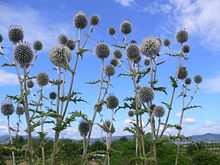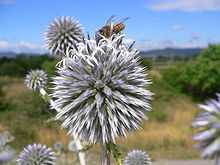Echinops sphaerocephalus
| Echinops sphaerocephalus | |
|---|---|
 | |
| Scientific classification | |
| Kingdom: | Plantae |
| (unranked): | Angiosperms |
| (unranked): | Eudicots |
| (unranked): | Asterids |
| Order: | Asterales |
| Family: | Asteraceae |
| Tribe: | Cynareae |
| Genus: | Echinops |
| Species: | E. sphaerocephalus |
| Binomial name | |
| Echinops sphaerocephalus L. | |
| Synonyms | |
| |
Echinops sphaerocephalus, known by the common name Great globe thistle or Pale globe-thistle, is a species of globe thistle belonging to the family Asteraceae.
Etymology
The genus name derives from the Greek words "ekhinos" meaning "hedgehog" and "opisis" meaning "aspect", with reference to the appearance of the inflorescence, while the species name sphaerocephalus derives from the words "sphaera" meaning "round" and "kephalos" meaning head.
Description

Its erect, branching, gray, slightly wrinkled and hairy stems bear the occasional large, soft, sharply toothed, sharp-lobed pointed green leaves. They are sticky hairy above, and white woolly below.
Atop each stem is an almost perfectly spherical inflorescence up to 6 cm in diameter, packed with white or blue-gray disc florets. It flowers from June until September.[1]
The flowers are pollinated by insects (usually bees, wasps and butterflies) (entomogamy) and are hermaphrodite (self fertilization or autogamy). The fruits are hairy cylindrical achenes about 7 to 8 mm long. They ripe from September through October. The seed dispersal is granted by wind (anemochory).
Distribution
This species is native to Eurasia but it lives on other continents where it was introduced, including North America where it is a widespread weed. It is very common in the mountains of southern France and southern and central Europe.
Habitat
It grows in sunny, rocky or brushy places, with more or less mineral rich soils, at an altitude of 0–400 metres (0–1,312 ft) above sea level.
Subspecies
- Echinops sphaerocephalus L. subsp. albidus (Boiss. et Spruner) Kozu.
- Echinops sphaerocephalus L. subsp. sphaerocephalus
Gallery
-

Illustration of Echinops sphaerocephalus from Flora von Deutschland, Österreich und der Schweiz, 1885
-
Close-up on flowers of Echinops sphaerocephalus
-
Inflorescence of Echinops sphaerocephalus pollinated by a butterfly
-
Leaf of Echinops sphaerocephalus
References
- ↑ Rose, Francis (1981). The Wild Flower Key. Frederick Warne & Co. pp. 386–387. ISBN 0-7232-2419-6.
External links
| Wikimedia Commons has media related to Echinops sphaerocephalus. |
| Wikispecies has information related to: Echinops sphaerocephalus |
- ASTERACEAE, SUNFLOWER FAMILY, The Jepson Manual
- USDA Plants Profile
- Globe Thistle, Ontario Weeds
- Echinops sphaerocephalus, alterVISTA
- Biolib


